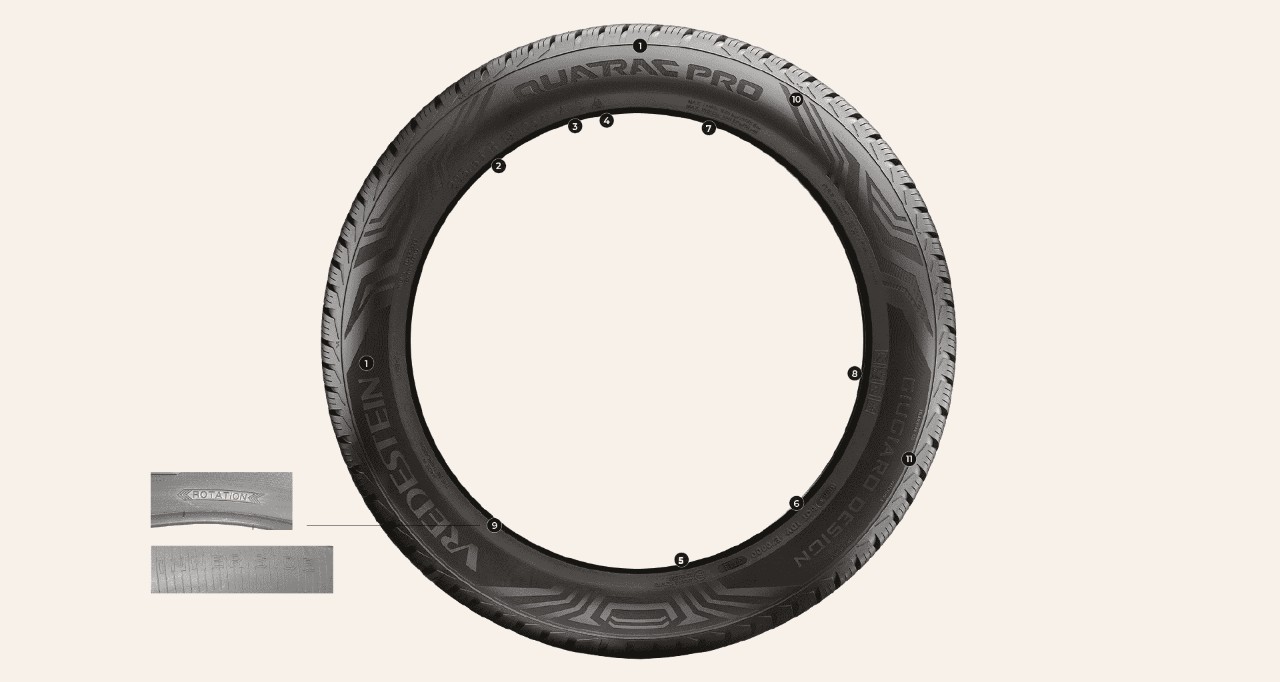12 15,2022
What do the symbols on your tyre mean?
To the untrained eye, the sidewall of a tyre appears filled with incomprehensible numbers, letters, and symbols. These indicators are there to make it easier for you when you need to change tyres and to let the car mechanic know immediately what tyres your car is fitted with. But what is their meaning?
Vredestein Tyre Academy | Episode 6: Symbols on a Tyre
Let's look one by one in detail at what the most basic of these tyre hieroglyphs mean.
1. The name of the manufacturer (Vredestein) is listed along with the commercial name (Quatrac Pro) of the tyre.
2. These series of numbers are the size description of a tyre. Taking the example of 275/30 R20 97Y, the number 275 indicates the tyre width in millimeters; 30 is the aspect ratio, the height-to-width ratio expressed as a percentage (30%); R stands for radial and specifies the construction of the carcass; and 20 is the rim diameter in inches. Additionally, the number 97 implies the load index, which corresponds to the maximum amount of weight the tyre can carry when driving. The letter "Y" suggests the maximum speed capacity of the tyre.
3. The M+S or M&S (mud and snow) symbol is usually found on winter, all-season, and 4X4 tyres with self-cleaning treads and average traction in muddy or snowy conditions. The M+S marking, together with the "snowflake" symbol, indicates a purely winter tyre.
4. The "snowflake" symbol, officially called the "Three-Peak Mountain Snowflake" or "3PMSF-symbol," indicates that the tyre meets all the requirements of special winter tests and is a true winter performance tyre.
5. The capital E in a circle is the ECE type approval mark, which indicates that the tyre has been tested and approved by the European Regulatory Authorities. The number next to "E" is the country code from which the certificate was issued. (e.g., 4=Netherlands). Along with the European approval number is the S2WR2 code, which implies the external noise level, wet grip, and rolling resistance.

6. The DOT symbol stands for the Department of Transport. It consists of the code of the production location (3 digits), the code of the tyre size (2 digits), the construction code (4 digits), and the production week (the last 4 digits). The "production week" is a 4-digit number that identifies the exact date and year of manufacture. The first two letters specify the week, and the last two point to the year of manufacturing (e.g., 4322, week 43 of 2022).
7. The MAX LOAD symbol indicates the maximum amount of weight that a tyre can carry. It is accompanied by the MAX PRESS (maximum tyre pressure) symbol, which explains the maximum pressure that can be used.
8. It is an Apollo Vredestein symbol that identifies a tyre as all-season.
9. The rotation symbol can be found on directional tyres. It is indicated by an arrow and the text "ROTATION". The "INNER SIDE" symbol (only used by Vredestein) indicates the inside fitting position of an asymmetric tyre.
10. Treadwear indicator. TWI. In Vredestein, we use the VR symbol located above the sidewall. This symbol shows the position where you can find the treadwear indicators in the main tread grooves, and it demonstrates the minimum tread depth (1.6 mm) the tyres are allowed to use. It can be found in 6 different locations around the tyre.
11. Treadwear, traction, and temperature are the UTQG mandatory symbols for the United States. Treadwear stands for the mileage, traction for the grip, and temperature for the high-speed properties.
.jpg)

